Azul board game review

It’s hard for an abstract strategy game to make its way in this world.
The masses clamor for board games dripping with theme. Like with movies and books, players are drawn to games that help them escape into a new realm.
So when an abstract board game comes along and wins the coveted Spiel des Jahres (Game of the Year) award, people take notice.
Such is the case with Azul by Plan B Games and Next Move Games.
To be fair, Azul does have a theme tied to it: Players are tile laying artists decorating the walls of the Royal Palace of Evora, Portugal. However, it’s really just a way to present a beautifully crafted abstract game. While the theme may feel flat for us, the game play is completely the opposite — we really enjoy it!
We can see why Azul sold out so quickly from it’s first couple print runs — because it’s a fantastic board game and great for families!
How to play Azul
In Azul players take turns drafting colored tiles to their personal player board. Later in the round, players score points based on how they place their tiles to decorate their wall of the palace. Extra points are scored for specific patterns and completing sets while wasted tiles decrease player scores. The player with the most points at the end of the game wins.
The game is easy to teach new players because of how simple the rules are.
To begin, players set out a number of circular Factory boards in the center of the table depending on the number of players. The 20 tiles of each color are placed in the draw bag. From the draw bag, players randomly draw and place 4 tiles on each of the Factory boards.
Each player gets their own player board and they’re ready to begin.
The game is played over multiple rounds, each with 3 steps: Factory offer, Wall-tiling, Preparing the next round.
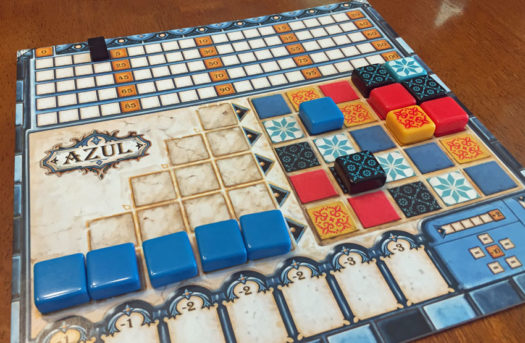
Factory Offer
On their turn, a player takes tiles from either one of the Factory boards or from the center of the table. When they take tiles, they must take all the tiles of their chosen color from the location.
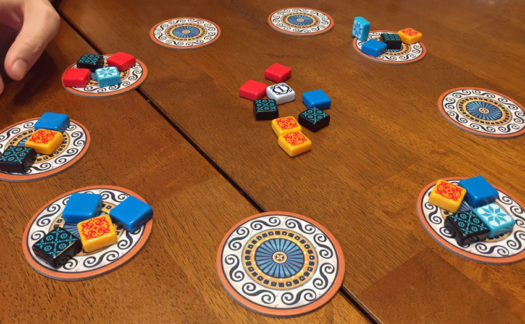
If they take from one of the Factory boards, they then place the tiles they didn’t take into the center of the table. If they take from the tiles in the center of the table, they likewise take all tiles of one color and leave the rest. If they’re they first to take tiles from the center of they table they also claim the starting player tile and place it on the leftmost space of their floor line on their player board. (They’ll be the starting player for the next round.)
After a player takes tiles, they must place them on one of the 5 pattern lines on their player board (left side of their board). If the pattern line already has tiles, players may only place tiles of that same color on that line. Once all spaces of a pattern line are filled, that line is considered complete. If the player still has more tiles of that color, they must place any excess tiles on their Floor Line (from left to right). Likewise, any tiles that a player takes that can not be added to one of their pattern lines following those rules, must place the tiles on their floor line.
In subsequent rounds, players are not allowed to place tiles of a certain color in a pattern line whose corresponding line of their wall already holds that color.
After a player has taken and placed tiles on their player board’s pattern line, it’s the next player’s turn. Play continues like this until all tiles have been claimed (from the Factory boards and center of the table). This ends the Factory Offer phase.
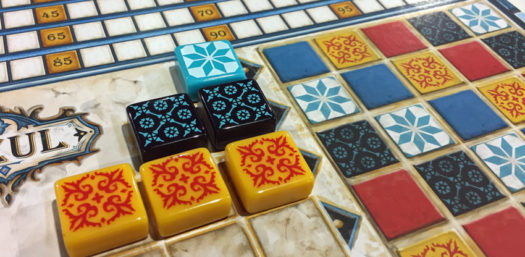
Wall-tiling
During the wall-tiling phase, players move tiles from their pattern lines on the left to their wall area on the right side of their player board. Players perform this simultaneously (no need to take turns).
From top to bottom, players move one tile from each completed pattern line to the space of the same color in the corresponding line of the Wall. Each time a tile is placed on the Wall, it is scored immediately.
Then all remaining tiles from that pattern line are placed back in the game box lid.
Any tiles on pattern lines that aren’t complete remain in place for the next round.
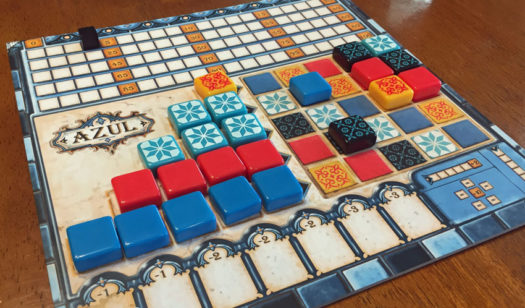
Scoring: When a tile is placed on the Wall it is scored. If there aren’t any tiles adjacent (vertically or horizontally) to the newly placed tile, it scores 1 point. If there are tiles adjacent, players count all the linked horizontal tiles (including the new tile) and get that many points. Then they do the same for any tiles vertically linked.
For example, if a tile is placed so that there’s a tile on all 4 sides of it, it will score 6 points (3 for the horizontally connected tiles and 3 for the vertically connected tiles).
Any tiles on the Floor Line are removed to the game box lid and the player subtracts the indicated number of points from their score.
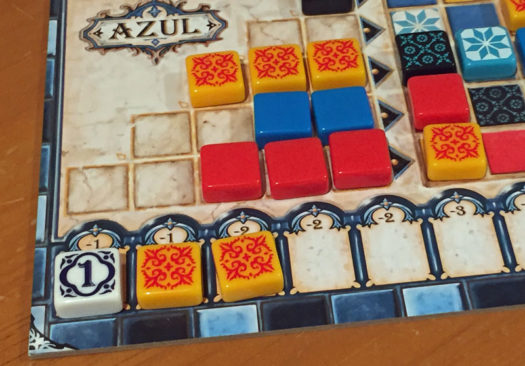
Preparing for Next Round
If the game hasn’t ended yet, players prepare for the next round.
Players refill the Factory boards with 4 random tiles each. When the draw bag is empty, players refill the bag with tiles that have been set aside in the game box lid. Then continue filling the Factory boards.
Then the player who had taken the starting player marker begins the new round.
Game End
The game ends at the end of the round in which at least one player has completed at least one horizontal row of their Wall.
After scoring as normally that round during the Wall-tiling phase, players score bonus points.
For each completed horizontal line in their Wall, players score 2 bonus points.
For each completed vertical column in their Wall, players score 7 bonus points.
If a player has placed 5 tiles of the same color in their Wall, they score 10 bonus points for that color.
The player with the most points wins!
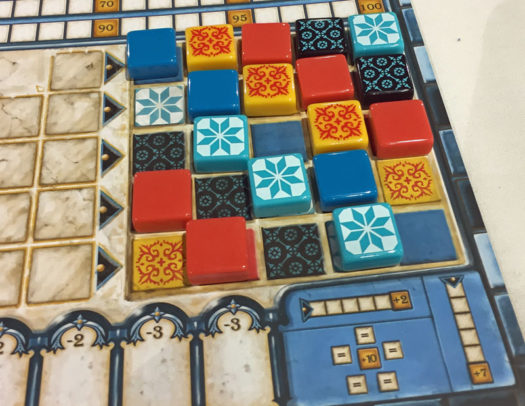
Why we like playing Azul
It’s a good thing board games don’t have to have a cool theme to be awesome. Don’t get me wrong, we love a lot of games with engaging themes. But we also enjoy a ton of games without any theme at all.
Azul is a stellar game without needing a strong theme.
There are a number of reasons why we really like it.
For starters, it’s got simple rules that are easy to teach, understand, and remember. Yet with those simple rules comes a depth of choices that keep it interesting throughout.
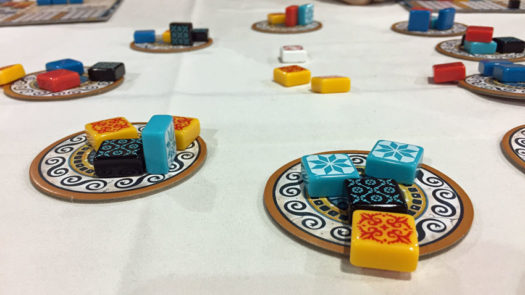
At the start of each round there are many choices players can make about which colored tiles to grab. But there are a lot of factors to consider when making those choices. First of all is what colors you need to complete your Wall. Second is which row to place those tiles on. And for that choice, the number of tiles in that color available is a major factor. Because if you can’t complete a row on the left this round, you won’t be able to move a tile into place in your Wall on the right.
Since players score more points for placing tiles next to tiles already on the board, you’ll also have to choose colored tiles based on which will score you well now and which will set you up for big scoring rounds later. And sometimes that “later” choice means the bonus points you’ll score at the end of the game.
Then there’s the element of knowing which colored tiles your opponents will be going after. All information is open to all players. Everyone can see which colors and spaces are open on the other players’ boards. So you’ll have a good idea of which options they may be considering. Will the tiles you want still be around by the time your turn comes around again, or should you take them now?
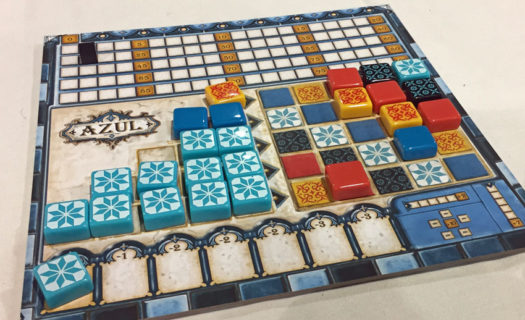
In 2-player games, the back-and-forth tile selection is even more direct and impactful. The can especially happen near the end of the tile selection phase when a player can force their opponent to take tiles they can’t place — thus making them drop tons of tiles to their Floor Line which will lose them points.
Lastly, there’s also the choice of when to snag the starting player tile from the center of the table. Do you only take it when the colored tiles in the center hit the the exact amount you need? Or do you take tiles from the center first to ensure you’ll get first pick of all tiles in the next round. Doing so will cost you 1 point this round, but it may be totally worth it in the end.
We love those layers of decisions in a game that can be played in under 30 minutes.
And of course, the beautifully crafted tiles are like icing on the cake!
The both look and feel wonderful. They have a good weight and are fun to play with. Just be careful not to have Starburst candies around while playing because you may mistake the red tiles for strawberry candies…
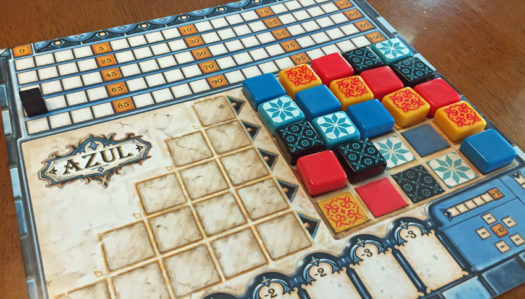
How does Azul score on our “Let’s Play Again” game meter?
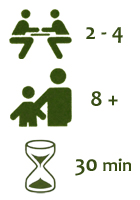 Azul scores very high on our “let’s play again” game meter. Since the only set up is throwing all the tiles back in the draw bag, it’s very easy to play games back-to-back.
Azul scores very high on our “let’s play again” game meter. Since the only set up is throwing all the tiles back in the draw bag, it’s very easy to play games back-to-back.
It’s also fun to play back-to-back games because players will play off of each other differently from game to game. We’ve found second games have players keeping an eye on their opponents even more closely.
Azul is also a game that will stay near the front of our game shelf because it’s a game we’ll reach for to introduce to new players.
We’d like to thank Miniature Market for a review copy of Azul.


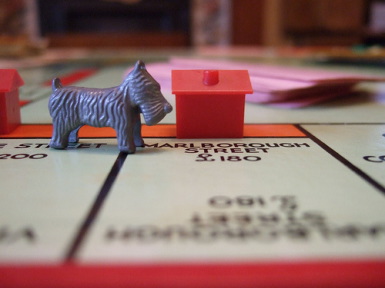



Excellent review. I have had my eye on this one as a good couple game, and it sounds from this like two players works nicely!
What about with kids? Do you think their 8+ recommendation is accurate, or could younger (say, 6+) grasp the gameplay?
Josh – Glad to hear our review was helpful. It’s tough to make general statements on age for games because everyone develops so uniquely. That being said, the basic flow of play could be understood by a 6-year old (take matching colors, put them on your board, when you fill a row, move it to the right on a matching space). They may not understand the scoring as easily or understand how to set up for bigger scoring later and bonus scores. But that won’t stop them from having fun. And with repeated plays, like all of us, they’ll come to understand some of those other elements.
I finally got a chance to play Azul this past weekend at TimpCon. I played it 5 times and really enjoyed it. It’s got just enough depth and thinking balanced with a quick play time.
I only played with 3 or 4 players so I’m glad to hear as well that you found it working well with just 2 (since a lot of times it’s just my wife and I playing).
This may have to make its way into our collection. 🙂
Okie – It’s definitely a keeper in our family.
Any highest score here? My 9 years old daughter just reach 156 in grey side of Azul 1. And 162 in Azul 3.